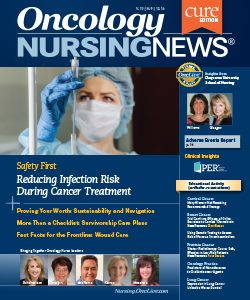Rapid Response Teams and End-of-Life Care in Oncology
Rapid response teams (RRT) are used extensively in many hospitals, including major cancer centers; however, research shows that adverse outcomes are more common for patients who require RRT intervention than among the general hospital population.
Marcella Williams, DNP, RN, AOCN, CMSRN

Marcella Williams, DNP, RN, AOCN, CMSRN
Mary Ellen Smith Glasgow, PhD, RN, ACNS-BC, ANEF, FAAN

Mary Ellen Smith Glasgow, PhD, RN, ACNS-BC, ANEF, FAAN
Marcella Williams is an assistant professor at Lansing Community College in Michigan. She completed her doctor of nursing practice degree program at Duquesne University School of Nursing, where Mary Ellen Glasgow is professor and dean.
With the advent of major cancer centers and the trend to provide increasingly aggressive treatments, the dilemma of what constitutes best care for patients with advanced cancer is an important one. Rapid response teams (RRT) are used extensively in many hospitals, including major cancer centers; however, research shows that adverse outcomes are more common for patients who require RRT intervention than among the general hospital population.1
Furthermore, RRT calls for patients with preestablished Do Not Resuscitate orders occur for a surprising number of patients,2 with as many as one-third of RRT calls involving patients at the end of life.3 Equally important are the timing of palliative care consultation, issues related to quality of life, and patient and family satisfaction with end-of-life care.4,5
Quality of Life Issues in the ICU
The role played by RRT members in end-of-life care is recognized and supported by research.4,6
A recent clinical review revealed an increasing proportion of hospital deaths in the intensive care unit (ICU) involve the withdrawal or withholding of life support measures.7 However, research focusing on family member perception of care quality for 1146 patients with cancer who died found that end-of-life care was rated as “excellent” most often when patients were not admitted to the ICU within 30 days of death and did not die in the hospital.5
Providing care for individuals nearing the end of life in the ICU is particularly important when such care often costs more than $4000 per day.8 Moreover, the study revealed that better quality of care was perceived when clients had received hospice services for more than 3 days prior to death.5
In their clinical review of intensivist and RRT roles in end-of-life care, Hilton, Jones, and Bellomo reported that 1 in 10 RRT calls result in new decisions to limit medical intervention, and one-third of calls involve end-of-life concerns.7 The authors suggest there may be limited resources on hospital wards to support early identification of patient deterioration and presented a timeline identifying key aspects of decision making and end-of-life discussions by clinicians and intensivists.7
Efforts to improve early identification of critical illness in patients with cancer resulted in the development of an admission and discharge ICU protocol for intensivists and yielded significant changes in placement for individuals with advanced cancer.9 Others have suggested end-of-life care is improved with the introduction of RRTs, particularly if end-of-life care training is an intentional part of team member education.7,10,11
Retrospective chart reviews revealed the most common RRT call is typically initiated for elderly individuals with multiple comorbid conditions, who often reside in nursing homes; most calls are made for individuals with orders for full resuscitation.6,12-17
Most of the individuals in these studies were admitted to the ICU unless decisions to alter resuscitation orders were made during the RRT event itself.14,16 A retrospective chart review of RRT calls made over a 2-year period conducted by Austin and colleagues showed that of the 557 clients seen by the RRT team, 135 were diagnosed with cancer. The oncology patient population had significantly higher mortality rates and used RRT resources at a much higher rate than those without cancer.6
Integrating Palliative Care
Efforts to prolong life via ICU admission can have a negative impact on the quality of life for patients and their loved ones, while integration of palliative care into the ICU environment can help reduce those costs and improve care quality.18
In a multisite study in US hospitals examining patient mental health and caregiver bereavement for individuals with advanced cancer, Wright et al found that end-of-life discussions were associated with earlier hospice enrollment, as well as decreased resuscitation and ICU admissions; however, aggressive care was associated with decreased patient quality of life and increased risk of major depression in caregivers.19
Two multicenter studies completed in academic hospitals in Toronto showed a higher prevalence of palliative care consultations over a 5-year period after RRTs were introduced, but also demonstrated that those clients receiving RRT services were less likely to have a palliative care consultation, a spiritual care consultation, or an order for sedatives.12,13
Both studies led the authors to conclude that although there is a huge need for RRT members to be involved in end-of-life care, opportunities to facilitate end-of-life care discussions and treatment may be missed, and ultimately the introduction of an RRT did not improve the quality of care being provided for those facing end-of-life concerns.12,13
Oncology nurses play a vital role in every point along the trajectory of care. As frontline providers, the nurse is often the individual initiating a rapid response event and may be the first healthcare provider to begin a conversation regarding advanced care planning and end-of-life care.
The crucial conversation should include data that less intense care does not equate to poor quality of life or limited productive lifespan for patients.17,20 Therefore, nurses’ familiarity with research related to RRT events, the role RRT members play in end-of-life care discussions and decisions, and the potential impact of RRT events on client and family outcomes, can guide future interactions and care provision.
Including palliative care content in nursing curricula is another vital aspect of effectively addressing best practice for end-of-life. Finally, the use of nurse-driven palliative care consults throughout the hospital, including the emergency department, has the potential to optimize care.21
References
- Jones D, Warrillow S. Clinical deterioration in cancer patients--the role of the rapid response team. Crit Care Med. 2014;42(4):997-998.
- Coventry C, Flabouris A, Sundararajan K, Cramey T. Rapid response team calls to patients with a pre-existing not for resuscitation order. Resuscitation. 2013;84(8):1035-1039.
- Jones D, Moran J, Winters B, Welch J. The rapid response system and end-of-life care. Curr Opin Crit Care. 2013;19(6):616-623.
- Hui D, Kim S, Roquemore J, Dev R, Chisholm G, Bruera E. Impact of timing and setting of palliative care referral on quality of end-of-life care in cancer patients. Cancer. 2014;120:1743-1749.
- Wright AA, Keating NL, Ayanian JZ, Chrischilles EA, Kahn KL, Ritchie CS, et al. Family perspectives on aggressive cancer care near the end of life. JAMA. 2016;315(3):284-292.
- Austin CA, Hanzaker C, Stafford R, Mayer C, Culp L, Lin FC, et al. Utilization of rapid response resources and outcomes in a comprehensive cancer center. Crit Care Med. 2014;42(4):905-909.
- Hilton AK, Jones D, Bellomo R. Clinical review: the role of the intensivist and the rapid response team in nosocomial end-of-life care. Crit Care. 2013;17(2):224.
- Huynh TN, Kleerup EC, Raj PP, Wenger NS. The opportunity cost of futile treatment in the ICU. Crit Care Med. 2014;42(9):1977-1982.
- McGovern J, Brash J, Eckhardt S, Rodriquez A, Hoag JB. Improvements in early recognition of critical illness in cancer patients through a combined nursing-physician admission/discharge criteria protocol. American Journal Respiratory Critical Care Medicine online abstracts. Accessed July 14, 2016. http://www.atsjournals.org/doi/abs/10.1164/ajrccm-conference.2014.189.1_MeetingAbstracts.A5246
- Nelson JE, Mathews KS, Weissman DE, Brasel KJ, Campbell M, Curtis JR, et al. Integration of palliative care in the context of rapid response: a report from the improving palliative care in the ICU advisory board. Chest. 2015;147(2):560-569.
- Tan LH, Delaney A. Medical emergency teams and end-of-life care: a systematic review. Crit Care Resusc. 2014;16(1):62-68.
- Downar J, Rodin D, Barua R, et al. Rapid response teams, do not resuscitate orders, and potential opportunities to improve end-of-life care: a multicentre retrospective study. J Crit Care. 2013;28(4):498-503.
- Downar J, Barua R, Rodin D, et al. Changes in end of life care 5 years after the introduction of a rapid response team: a multicentre retrospective study. Resuscitation. 2013;84(10):1339-1344.
- Jones DA, McIntyre T, Baldwin I, et al. The medical emergency team and end-of-life care: a pilot study. Crit Care Resusc. 2007;9(2):151-156.
- Sulistio M, Franco M, Vo A, Poon P, William L. Hospital rapid response team and patients with life-limiting illness: A multicentre retrospective cohort study. Palliat Med. 2015;29(4):302-309.
- Tam B, Salib M, Fox-Robichaud A. The effect of rapid response teams on end-of-life care: a retrospective chart review. Can Respir J. 2014;21(5):302-306.
- Jones DA, Bagshaw SM, Barrett J, et al. The role of the medical emergency team in end-of-life care: a multicenter, prospective, observational study. Crit Care Med. 2012;40(1):98-103.
- Curtis JR, Engelberg RA, Bensink ME, Ramsey SD. End-of-life care in the intensive care unit: can we simultaneously increase quality and reduce costs? Am J Respir Crit Care Med. 2012;186(7):587-592.
- Wright AA, Zhang B, Ray A, Mack JW, Trice E, Balboni T, et al. Associations between end-of-life discussions, patient mental health, medical care near death, and caregiver bereavement adjustment. JAMA. 2008;300(14):1665-1673.
- Dartmouth Atlas Project Report. Inpatient days per decedent during the last six-months of life, by gender and level of care intensity. Accessed Oct 1, 2015. http://www.dartmouthatlast.org/data/topic/topic.aspx?cat=18
- Middlesex Hospital Nursing Annual Report 2014. Engaging the interprofessional team in scholarly practice: validating the decision aid palliative referral (DAPR). Accessed August 1, 2016]. https://middlesexhospital.org/nursing-annual-report/2014#page/18.

Innovative Program Reduces Nurse Turnover and Fosters Development
Published: September 12th 2024 | Updated: September 12th 2024The US Oncology Network (The Network) has developed one of the most comprehensive programs in the nation to support the professional development and retention of new oncology nurses.


